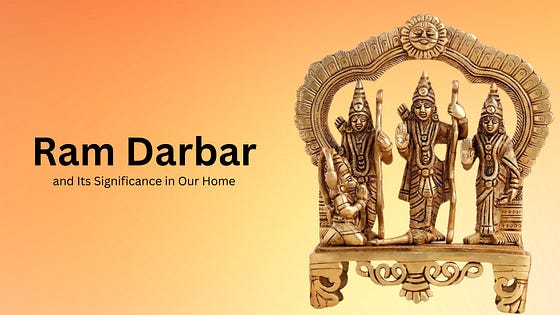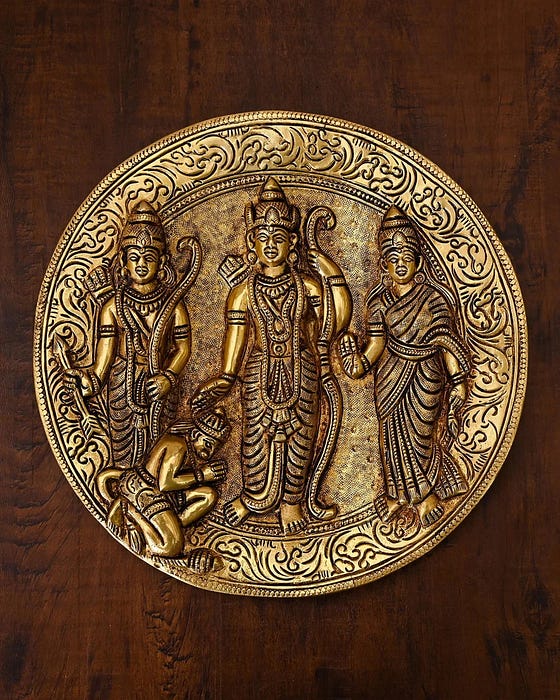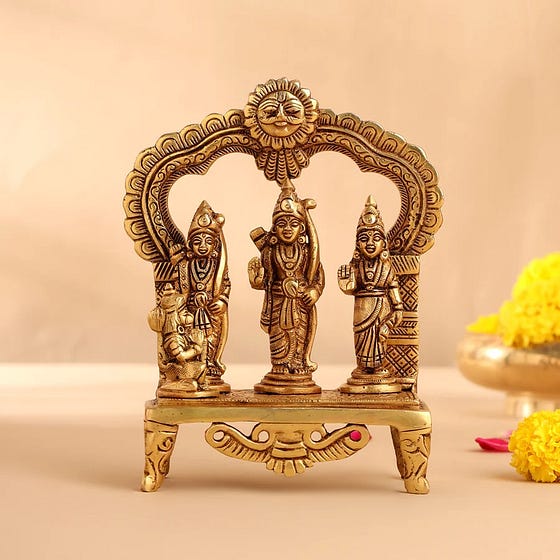
Ram Darbar, a revered religious symbol in Hinduism, represents the divine family of Lord Rama. This sacred depiction consists of Lord Rama, his wife, Goddess Sita, his loyal brother Lakshmana, and the devoted monkey god Hanuman. The term “Darbar” translates to “court” or “assembly,” emphasizing the divine gathering. Ram Darbar serves as a visual manifestation of the ideals of righteousness, virtue, and familial harmony in Hindu culture.
Religious and spiritual symbols are crucial in creating an environment of faith, devotion, and cultural identity within homes. These symbols, like Ram Darbar, remind people of the values and principles individuals hold dear. They contribute to the spiritual atmosphere of the household, fostering a sense of connection to tradition and providing a source of strength and solace during challenging times. Furthermore, these symbols often serve as focal points for prayer and meditation, enhancing the overall well-being of individuals and families.
The origin of Ram Darbar can be traced back to ancient Hindu scriptures, particularly the epic Ramayana. The Ramayana narrates the life and adventures of Lord Rama, highlighting his exemplary qualities as a king, husband, and devotee of dharma (righteousness). Over time, artists and sculptors have interpreted and depicted these characters, giving rise to various forms of artistic representations of the divine family, collectively known as Ram Darbar.
Ram Darbar holds profound cultural and religious significance in Hinduism. It symbolizes the ideal familial structure and the importance of righteousness (dharma) in one’s life. The characters in Ram Darbar are revered as embodiments of virtue, duty, and devotion, making their presence in homes a source of inspiration for individuals seeking a moral and spiritual compass. Additionally, the cultural festivals and rituals associated with the Ramayana often involve the worship of Ram Darbar, further solidifying its importance in the religious landscape.

Components of Ram Darbar
Ram Darbar is a timeless symbol that encapsulates Hinduism’s rich cultural and religious heritage. The artistic and symbolic representation of Lord Rama, Goddess Sita, Lord Lakshmana, and Lord Hanuman within this divine assembly is a powerful source of inspiration and guidance for individuals and families striving to lead righteous and virtuous lives.
- Lord Rama
Lord Rama, the seventh incarnation of Lord Vishnu, is typically depicted with a serene countenance, holding a bow and arrow — a representation of his prowess as a warrior. He is often adorned in royal attire, symbolizing his role as a just and noble king.
Lord Rama’s image symbolizes virtues such as righteousness, truth, and duty. The bow and arrow represent his commitment to protecting dharma and upholding justice. His portrayal emphasizes the qualities individuals aspire to embody in their lives.
- Goddess Sita
Goddess Sita, the consort of Lord Rama, is depicted as the epitome of feminine grace and virtue. She is often portrayed with a dignified demeanor, adorned in traditional attire and jewelry.
Sita’s presence in Ram Darbar symbolizes the ideal wife and mother. Her unwavering devotion to Lord Rama and her resilience during times of adversity inspire women, highlighting the importance of loyalty, purity, and strength in familial relationships.
- Lord Lakshmana and Lord Hanuman
Lord Lakshmana, the devoted brother of Lord Rama, is depicted as a loyal companion who willingly followed his elder brother into exile. His presence in Ram Darbar emphasizes the importance of familial bonds and selfless service.
Lord Hanuman, the mighty monkey god and devotee of Lord Rama, plays a central role in the Ramayana. His unwavering devotion and extraordinary strength make him a revered figure, symbolizing devotion and selfless service.
Lakshmana symbolizes loyalty, duty, and sacrifice within familial relationships. Hanuman represents unwavering devotion and the limitless potential that devotion unlocks. Through their roles and attributes, both characters contribute to the holistic representation of familial and divine ideals in Ram Darbar.
Spiritual and Cultural Reasons for Having Ram Darbar
Ram Darbar is a focal point for spiritual practices and devotion within the home. The presence of these divine figures fosters a sense of connection to the sacred and provides a visual representation of the values and ideals individuals aspire to uphold.
Moreover, having Ram Darbar in the home is a way of preserving and continuing cultural traditions. It reflects a deep-rooted connection to the Ramayana and the broader cultural heritage of Hinduism, contributing to transmitting cultural values across generations.
Placement Considerations of Ram Darbar Within the Home
- Central Location: Placing Ram Darbar in a central and prominent location within the home, such as the prayer room or main living area, ensures that it becomes a focal point for daily worship and reflection.
- Directional Considerations: Following Vastu or other cultural guidelines for placement can be considered, emphasizing creating a positive and harmonious energy flow within the living space.
- Respectful Placement: The idols should be positioned at an elevated and clean place, signifying reverence. Additionally, it is common practice to ensure that they are not placed directly on the floor.
Rituals and Practices Associated with Ram Darbar
- Daily Pooja: Engaging in daily rituals, such as morning and evening prayers (pooja), is common. This may involve offering the deities flowers, incense, and food, accompanied by reciting sacred verses and mantras.
- Festive Celebrations: Ram Darbar becomes a central focus during festivals like Diwali and Ram Navami, where elaborate decorations, special prayers, and community celebrations occur.
- Special Occasions and Life Events: Families often turn to Ram Darbar during significant life events, such as weddings, birthdays, and other ceremonies, seeking blessings and guidance from the divine figures.
Significance in Daily Life
- Moral Guidance: The stories and principles associated with Ram Darbar provide moral and ethical guidance, shaping the family’s values and conduct.
- Teaching Virtues: Parents often use the characters in Ram Darbar to instill virtues such as honesty, loyalty, and selflessness in their children, reinforcing positive behavior.
- Teaching Spiritual Discipline: Regular rituals and prayers instill a sense of spiritual discipline, promoting a mindful and contemplative way of life.
- Creating a Sacred Space: Ram Darbar transforms the home into a sacred space, influencing the overall atmosphere and promoting peace, harmony, and positivity.
- Strengthening Family Bonds: The shared act of worship and devotion brings family members together, fostering a sense of unity and shared purpose within the household.
Festivals and Celebrations with Ram Darbar
- Diwali: Ram Darbar is often a centerpiece during Diwali celebrations, symbolizing the triumph of light over darkness and the victory of good over evil.
- Ram Navami: This festival, celebrating the birth of Lord Rama, involves special prayers, processions, and worship centered around Ram Darbar.

Incorporating Ram Darbar in Modern Interior Design
In modern interior design, there is a trend toward minimalism. Individuals may opt for subtle and understated representations of Ram Darbar, integrating the divine family into the overall aesthetic without overwhelming the space. Ram Darbar can be incorporated into functional elements of the home, such as furniture, lighting fixtures, or wall art, seamlessly blending the sacred with the practical.
Some may choose interactive displays, such as digital projections or dynamic lighting, to create visually engaging representations of Ram Darbar that evolve with different moods or occasions.
The modern interpretations and adaptations of Ram Darbar demonstrate its dynamic and versatile nature. By blending tradition with contemporary expressions, individuals preserve cultural heritage and ensure that the spiritual essence of Ram Darbar remains relevant and meaningful in the context of modern living. It invites each person to weave their unique spiritual tapestry within the fabric of tradition, fostering a sense of connection and harmony in their homes.
Reference Link:
https://medium.com/@vedanshcraft.seo/ram-darbar-and-its-significance-in-our-home-68cea3e4d17e
https://vedanshcraft12.livejournal.com/831.html
https://justpaste.it/ce9rl
https://penzu.com/p/a43840b184156316


No comments